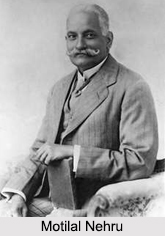 Prepared by a committee of the All Parties Conference chaired by Motilal Nehru and Jawaharlal Nehru as the secretary, the Nehru Report of 28th to 30th August, 1928, was a memorandum that outlined the new dominion status for the Constitution of India. There were 9 other members in this committee and the final report was signed by Motilal Nehru, Ali Imam, Tej Bahadur Sapru, Madhav Shrihari Aney, Mangal Singh, Shoaib Qureshi, Subhash Chandra Bose and G. R. Pradhan.
Prepared by a committee of the All Parties Conference chaired by Motilal Nehru and Jawaharlal Nehru as the secretary, the Nehru Report of 28th to 30th August, 1928, was a memorandum that outlined the new dominion status for the Constitution of India. There were 9 other members in this committee and the final report was signed by Motilal Nehru, Ali Imam, Tej Bahadur Sapru, Madhav Shrihari Aney, Mangal Singh, Shoaib Qureshi, Subhash Chandra Bose and G. R. Pradhan.
Background of Nehru Report
In 1928, when the Simon Commission came to India, it was vehemently opposed by Indians especially the Congress Party for the lack of a single Indian in the Commission. So, the Secretary of State for India, Lord Birkenhead challenged the Indian leaders to draft a constitution for India, implicitly implying that Indians were not capable of finding a common path and drafting a constitution. Leaders of the nationalist movement responded to the challenge by drafting the Nehru Report. This was the first major attempt by Indians to draft a constitution by them.
Key Features of Nehru Report
Some of the important elements of the Nehru Report are as follows:
Granting India dominion status with the parliamentary form of government with bi-cameral legislature that consists of senate and House of Representatives.
The report contained a Bill of Rights along with no separate electorate and no state religion.
The Nehru Report also stated that the senate should comprise of 200 elected members for 7 years and the House of Representatives should consist of 500 members elected for 5 years. It was to be collectively responsible to the parliament.
The Governor- General would be the constitutional head of India and act on the advice of executive council.
It included a description of the machinery of government including a proposal for the creation of a Supreme Court and a suggestion that the provinces should be linguistically determined.
The Nehru Report also wanted one- third representation of the Muslims in the Central Legislature but no reservation of seats for communities in Punjab and Bengal.
There should be a federal form of government in India with residuary powers to be vested in Centre.
Response to Nehru Report
The Nehru Report proposed to abolish separate electorates, to discard reservation of seats for Muslim majorities in the Punjab and Bengal and to reject the principle of weight age for Muslim minorities. This was a reversal of the Lucknow Pact. The novel features of the Nehru Report were almost accepted by the Indian leaders and with the exception of few Muslim League leaders; the Nehru proposals were mostly rejected.
In reaction Mohammad Ali Jinnah drafted his Fourteen Points in 1929 which became the core demands the Muslim community put forward as the price of their participating in an independent united India. Their main objections were:
Separate electorates and weight age - the Lucknow Pact provided these to the Muslim community whereas they were rejected by the Nehru Report.
The Nehru Report wanted the residual powers in the Centre, whereas in Jinnah"s Fourteen Points, they wanted the residual powers to be vested within the provinces.
In the 1928 Calcutta session, the Nehru Report was accepted by a majority vote. The congress gave an ultimatum to the British Government to accept the recommendations of the report by December 31st, 1929, and also threatened for another mass movement in case the report is not accepted. The report was not accepted by the Government.






































